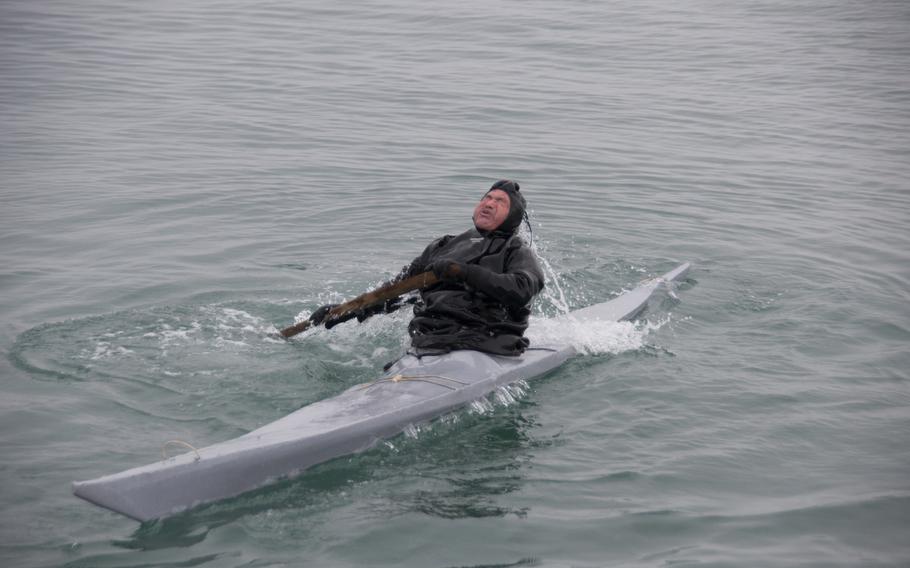
Outdlaq Qujaukitsoq comes up for air while demonstrating how to roll his kayak in front of a small but appreciative and apprehensive crowd watching from the Thule Air Base main pier. (Patrick Dickson/Stars and Stripes)
This article first appeared in print in the Stars and Stripes Global edition, Jan. 15, 2015. It is republished unedited in its original form.
THULE AIR BASE, Greenland — On a bitter late September day, in water temperatures at the base pier around 32 degrees, two Inuit men visiting Thule to demonstrate their culture took to the harbor in kayaks to show how they maneuver and roll and, mostly, how they stay alive.
“Cold,” said Outdlaq Qujaukitsoq as he splashed water on his face before executing rolls in the frigid water. “Next year, we do this in August.”
The day before, Mads Ole Kristiansen, from nearby Qaanaaq, came to Knud Rasmussen’s Community Center on Thule to explain traditional hunting practices to an appreciative crowd of 50 U.S. and Canadian military members, as well as the Danes who support them.
Both visits were part of a series of events designed to keep the people here from going stir crazy. Other distractions include movies, a hockey tournament and allterrain vehicle rides to the local waterfall.
Kristiansen shared his heritage with the crowd, his English halting.
“I was born in ’60, and that time, every Inuit boy, he must be doing with hunting,” he said. “And I was 8 years old. I was beginning with my father to fishing and hunting.”
He occasionally looked to fellow Greenlander and community center employee Helene Nielsen for help with a word, but the 54- year-old offered a 45-minute talk on Inuit hunting techniques.
As his daughter, Aviana, 5, and son, Suikkaq, 2, flitted around the room, playing under the pool tables, Kristiansen talked about the different seasons of hunting, quotas on how many of each animal he could kill in a season and how each was hunted.
Most Inuit retain their traditional first names but have Danish family names, the result of Danish priests ministering to the families starting in the early 20th century. They live and hunt much as their ancestors did.
“From my heart, I understand my past,” Kristiansen said. “They live here in high Arctic, and they hunt walrus, narwhal, polar bear and seal. ... Polar bear. Most important to us. Without polar bear, we are nothing.”
He talked about hunting narwhal.
“Many narwhal come in our fjord every summer, to make newborn,” he said, mentioning the national rules and quotas. “They want to keep narwhal in this area, and must be safe. No following narwhal in boat; they must be hunting in kayak. That why in 2014, there still narwhal in our fjord.”
He picked up a harpoon, the tip of which comes off when it enters the narwhal. It is attached to a rope, and at the other end is a balloon made of seal skin. The narwhal is easily tracked and becomes exhausted.
At the pier, the Inuit men were selling narwhal meat, as well as that of seal, musk ox and beluga whale — all laid out on plastic sheets.
The community center also had arranged for Thule personnel to sample some seal stew — a bit gamey but not unlike beef or venison — and narwhal soup, which did not have much taste, with onions and potatoes mixed in.
One Danish nurse, Karina Nielsen Kastberg, bought a five-pound hunk of musk ox.
“It’s good as steak, or minced. It’s like tasting heaven,” she said.
Soon the group of about 10 Inuit men and women began packing up and getting ready to set out for Qaanaaq, 60 miles north. In three days, it would be walrus season.